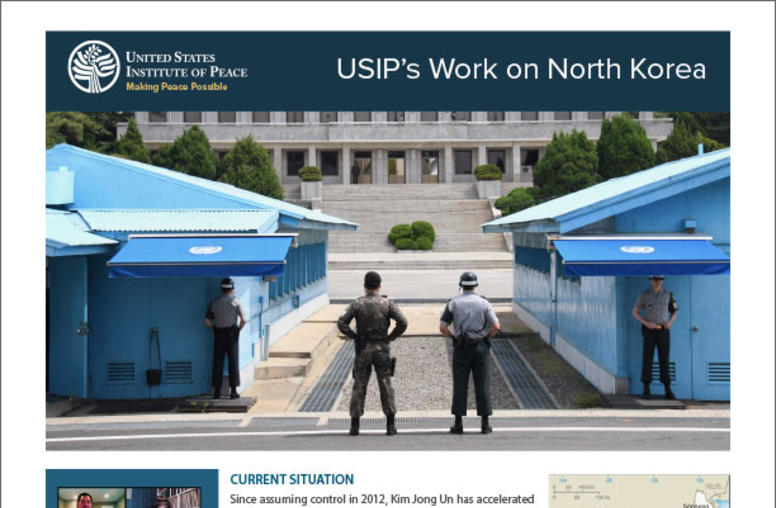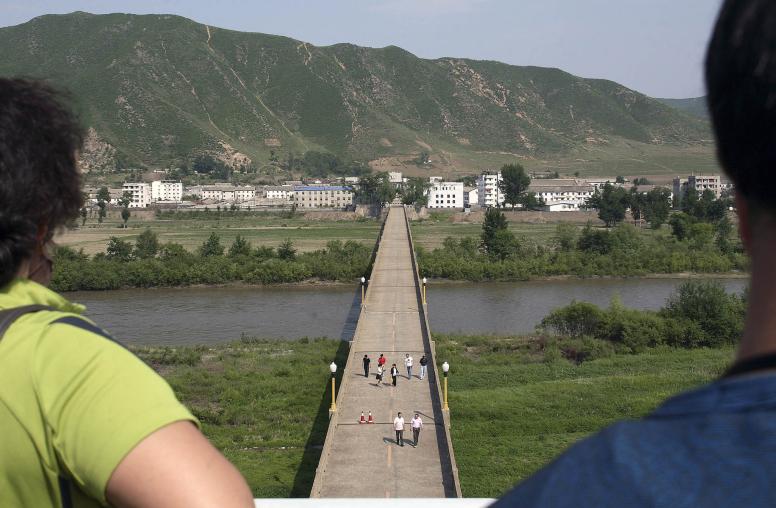Seeking Peaceful Coexistence with North Korea: What Would Kennan Do?
Risk reduction will require sustained engagement with Pyongyang as well as acceptance of realities that will continue to constrain U.S. options and preferences.
This essay is part of a series, Pursuing Peaceful Coexistence with North Korea, that explores how the United States and South Korea can peacefully coexist with a nuclear North Korea.
The challenge that North Korea poses to the United States — as a hostile, intransigent and seemingly implacable power with nuclear weapons — is in many respects a microcosm of the challenge posed by the Soviet Union during the Cold War. How would George F. Kennan, who devised the strategy of containment for dealing with the Soviet Union, have advised Washington in confronting Pyongyang?

Kennan’s Evolving Views of the Korean Peninsula
Kennan originally did not consider his doctrine of containment to be applicable to the Korean Peninsula because he deemed it strategically inconsequential, and thus judged that Soviet influence over it would be unfortunate but tolerable for the United States. In 1947, when he was formulating U.S. strategy as director of the Policy Planning Staff at the State Department, Kennan wrote that because the peninsula was “not of decisive strategic importance to us,” Washington’s “main task” there should be “to extricate ourselves [from postwar occupation] without too great a loss of prestige.”
The outbreak of the Korean War in June 1950, however, reversed Kennan’s position — but only because he judged that the extension of communist control “in the way in which this was attempted” would have been “wholly disruptive to our prestige in Asia.” Indeed, Kennan was prepared to accept a “gradual and inconspicuous” extension of Soviet control — again, because he considered the Korean Peninsula expendable.
In the ensuing decades, this position evolved as Kennan’s concern in East Asia shifted from containing the spread of Soviet influence to limiting the spread (after the Sino-Soviet split) of Chinese communist influence in the region. He wrote in 1964 that Washington “had no choice but to place ourselves in [the] path” of the expansion of Chinese power over “those insular and peninsular appendages of the Asiatic continent” — explicitly including South Korea — to which the United States had extended defense commitments in the wake of the Korean War.
Kennan, however, ultimately developed an ambivalent attitude toward both Koreas. He criticized administrations in Seoul that in his view were repressive, took the U.S. security umbrella for granted or interfered in U.S. politics; and he called South Korea a “dead weight” on U.S. policy toward Japan because of Seoul’s resistance to what he considered Washington’s need to focus its regional strategy on Tokyo. For those reasons, Kennan in the 1970s again came to advocate a U.S. military withdrawal from the peninsula. As for North Korea, he wrote that Pyongyang had retained its “burning hatred” of the United States for “standing in its way” in 1950, and he foresaw that North Korea would become “one of the most explosive and dangerous spots” in the world.
Containment as a Political and Economic Rather than Military Strategy
But it is important to recall that Kennan spent the latter half of his life insisting that he never intended containment to be exclusively or even primarily a military strategy. Nor did he intend it to exclude diplomatic engagement aimed at establishing the conditions and negotiating the terms for peaceful coexistence. Indeed, in a new biography — “Kennan: A Life Between Worlds” — historian Frank Costigliola emphasizes this aspect of Kennan’s Cold War career, which was eclipsed by Washington’s militarization of containment policy starting in the 1950s.
Focused on the limits of U.S. power and the requirement this imposed for some level of compromise and accommodation with the Soviet Union, Kennan advocated “serious diplomacy” aimed at “an honorable settlement that would reduce tensions.” Although he never abandoned containment, he had intended it to be primarily a political and economic strategy — the Marshall Plan in Europe was his original model — and he argued that containment needed to be accompanied by negotiations that might yield a “political settlement” that would avert conflict and facilitate a stable equilibrium even if fundamental disagreements persisted. As Costigliola observes, Kennan lamented that the militarization of containment thwarted opportunities for negotiation, and yielded a stability that was tenuous because it averted compromise and the need for “patience, sacrifice, and restraint.”
Applying Kennan’s Approach to the Soviet Union to the Current North Korea Challenge
Most of the same criteria apply to the challenge of dealing with Pyongyang today. Assessing Costigliola’s book, historian Fredrik Logevall underscored the need to “rethink the Cold War as an era of possibilities for dialogue and diplomacy, not the inevitable series of confrontations and crises we came to see.”
Washington has certainly seen a series of confrontations and crises with North Korea. And although it is a far less consequential power than the Soviet Union was, its nuclear and conventional military capabilities dictate the need for patience and restraint, and for negotiations in pursuit of peaceful coexistence. Moreover, a largely militarized approach to containing North Korea is unlikely to bring long-term stability to the Korean Peninsula because it similarly avoids both consideration of compromise and addressing Pyongyang’s legitimate security concerns. Kennan considered Washington’s approach to Moscow during the early stages of the Cold War as a futile pursuit of unconditional surrender, which is no more viable in the case of Pyongyang today.
Several other aspects of Kennan’s approach to the Soviet Union also resonate with regard to North Korea. Among these was his concern about the tendency of U.S. policymakers to caricature and vilify the strategic perspective of an adversary rather than acknowledge and confront the complexities of that perspective. Shortly after the outbreak of the Korean War in 1950, Kennan wrote that “there is a reluctance to recognize the finer distinctions of the psychology of our adversaries” because it seems safer to “credit him indiscriminately with all aggressive designs, even when some of them are mutually contradictory.” This is compounded by the presumption that strategic disputes are irreconcilable and thus peaceful coexistence is impossible. Kennan wrote in the 1970s that Washington appeared to assume that “the differences in aim and outlook between the Soviet Union and the United States are indeed of such a nature that no peaceful resolution of them is conceivable.” The same assumption is often prevalent in U.S.-North Korean relations.
A core problem, in Kennan’s view, was that such inflated threat perceptions and premature judgments, “like all false prophesies and all false images of conflict and enmity, tend to be self-fulfilling.” Moreover, such assumptions are partly grounded in a lack of strategic empathy, which hinders recognition of the impact Washington’s posture has on the mindset of the adversary. In the case of the Soviet Union, Kennan speculated that Soviet leaders were likely to see “sinister motives” behind the U.S. approach and conclude “that we have come to see war as inevitable and have put out of our minds all possibilities for the peaceful accommodation of our differences. If they gain this impression, then they too will tend to push such possibilities out of theirs.” Finally, Kennan observed that Washington was often averse to negotiating with Moscow because Russia was “identified as the epitome of evil, and it wouldn’t look good, from the domestic political standpoint, to be negotiating and compromising with evil.”
This all resonates with the current U.S. challenge of dealing with North Korea. Although there is ample U.S. analysis of the psychology of Kim Jong Un, there are limits to its accuracy and validity, given the hardness of the target (in intelligence community parlance). More importantly, Washington runs the risk of simplifying or rebuffing Pyongyang’s perspective, crediting it, in Kennan’s words, “indiscriminately with all aggressive designs,” underestimating both the potential for mutual accommodation and the impact of U.S. actions on conspiratorial North Korean thinking, and avoiding opportunities for constructive diplomacy because of the domestic political risks of advocating it.
No doubt Pyongyang poses multiple and glaring obstacles to a constructive U.S. approach. Its own obstreperous and belligerent posture has often been characterized by vilification and misattribution of U.S. motives, rather than any apparent embrace of restraint or compromise. Moreover, North Korea’s commitment to constructive diplomacy has failed several tests over the past three decades.
But for both sides, the long-term risks of avoiding reciprocal diplomacy are almost certainly greater than the risks and challenges of pursuing it. Notwithstanding the inevitable frustrations, minimizing the dangers to peace and stability will require sustained engagement with Pyongyang, as well as acceptance of realities that will continue to constrain U.S. options and preferences. These include recognizing the limits on U.S. power (which Kennan consistently emphasized) and thus on fulfillment of the U.S. wish list; and at least tacitly acknowledging that North Korea is a de facto nuclear state. Washington probably will also have to accept the need for reciprocity — “you can’t get something for nothing” when your negotiating partner has leverage — and some level of mutual respect.
None of this requires the United States to abandon either the traditional levers of containment or Washington’s formidable leverage over Pyongyang. As Kennan wrote early in the Cold War about the Soviet Union, the United States “has it in its power to increase enormously the strains under which Soviet policy must operate” and to “force upon the Kremlin a far greater degree of moderation and circumspection than it has had to observe in recent years.” The same potential now exists with regard to North Korea. But U.S. exercise of this power can and should be accompanied by a genuine belief in peaceful coexistence, and acknowledgement that Pyongyang itself is genuinely interested in the same.
With such an approach, Washington could pursue an interim settlement with Pyongyang — one that reduces risks and tensions and promotes stability on the Korean Peninsula — along the lines that Kennan proposed for dealing with China in the 1970s: “Let us collaborate where we can, agree to differ where we cannot, and see whether we cannot contrive to live reasonably peacefully together for the time being, despite our differences; not asking too much of each other—or too little.”
Paul J. Heer is a nonresident senior fellow at the Chicago Council on Global Affairs. He served as national intelligence officer for East Asia from 2007 to 2015. He is the author of “Mr. X and the Pacific: George F. Kennan and American Policy in East Asia.”



